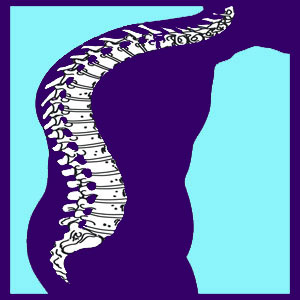
Do you need forward head posture relief? You are certainly not alone. Forward head posture is now an epidemic problem due to the obsession with handheld electronic devices and widespread growth of computer usage. People are spending more than half of their day hunched forward, staring into a tiny screen to interact with the outside world. The changes in posture demonstrated by the average person are now markedly visible compared to just 10 years ago. Not surprisingly, doctors are now also seeing tremendous numbers of patients complaining of pain that is a direct result of these postural changes to the neck and upper back.
Reader’s neck used to be a very rare diagnosis, typically reserved for religious scholars and academics who spent much of their time reading traditional books. Doctors also saw some examples of forward head positioning in awkward teenagers who were still coming to grips with proper posture. However, now anyone in the general population is at risk for demonstrating forward posture of the head, since peoples’ lives are literally dominated by use of mobile phones, computers and tablets, all of which can contribute to significant postural issues.
This treatise explores the expanding need forward head posture relief. We will define the condition, examine its causes and symptoms, as well as provide some guidance to help patients avoid potentially serious problems from the use of electronic devices.
Forward Head Posture Relief Defined
Forward head positioning is a relative term to anatomical normal posture. Usually, the ear should align with the middle of the shoulder when viewed from the sagittal perspective (side view). Forward head positioning is defined as holding the head in a way that the neck projects forward more than upward, with the ear aligning in front to of the shoulder line, often more in line with the clavicle.
Despite seeing this poor posture more and more in the modern world, it is not normal, nor is it healthy. The condition is a result of long periods of time spent maintaining abysmal posture. The actual anatomy is reshaped over months and years to become permanently situated in a manner that exponentially increases stress on the spine and dorsal musculature. While one day of slouched head posture will not do any damage (although it may cause acute, transient pain), extended timelines of regular poor posture will have a variety of negative implications on the upper spinal anatomy and will certainly set the stage for pain issues that might become very serious.
Carrying the head forward of the shoulder midline can increase the force of the head’s mass by huge amounts, straining soft tissues, hastening and worsening spinal degeneration and even reshaping the anatomy of the spine over time. Finding relief from forward head posture is a now a major goal of many people who have begun to suffer neck pain and related effects due to their excessive mobile phone use.
Forward Head Posture Relief by Causation
Some people demonstrate congenital or developed spinal abnormalities that can cause or contribute to forward head posture. These contributory conditions might include a range of neuromuscular diseases, torticollis, cervical, cervicothoracic or cervicothoracolumbar scoliosis, hyperkyphosis and some other possible sources. However, the number of these conditions is basically stable year to year or actually decreasing, while the incidence of forward head posture is markedly increasing each year.
The reason for the increase in forward head positioning is the epidemic reliance and obsession with handheld electronic devices, such as cell phones and tablets, as well as the exponential growth of computer-related jobs and pastimes. People are simply spending the majority of their waking time staring downward for very long periods of time, often without moving or stretching at all. This fact also explains why the majority of newly diagnosed cases of postural problems occur in teens and young adults.
Relieving Forward Head Posture Symptoms
Besides for the obvious unaesthetic physical appearance and anatomical presentation of forward head posture, there are also a variety of disconcerting symptoms that might exist:
Neck and upper back pain is very commonplace. Most people will suffer centrally or slightly off-center pain in between the shoulder blades in the upper back. Pain might exist all the time or might be linked to neck movement. Cervicogenic headaches are also commonly experiences, usually being unilaterally and with acute presentation of almost debilitating symptoms for numerous hours.
Patients might suffer uncomfortably tight and tense neck and upper back muscles, especially in the area in between the shoulders, at the base of the neck and following the extended lines of the trapezius muscles, from occiput to the lower middle back. Periods of stagnant positioning, such as when working or sleeping, often worsen these symptoms and make patients hesitant to move or face exacerbated pain.
Patients might suffer symptoms in areas on the face and head, including pain behind the ear, ringing in the ear, twitching in the lips or eyes, throat irritation and even increased chance for the development of Bell’s Palsy.
Some patients suffer irritation of the vagus nerve, leading to wide-ranging symptoms in the internal organs and digestive tract that are rarely clinically linked to the forward head posture, but are surely related.
Forward Head Posture Relief Tips
We are not going to discuss professional medical treatment for forward head posture in this essay, since we have already covered the topic, but instead will provide some helpful tips for self-treatment and prevention of the problem for proactive and conscientious readers who choose to stop pain before it occurs:
You can still work and play on your mobile device or computer. However, you will have to change your ergonomics in order to prevent problems. We recommend holding your mobile devices at eye level and alternating hands holding the device when using it on the go. Do not get into the habit of looking down at a device held at chest level or lower. This is bad! When practical, it is best to set your handheld device on a stand at eye level. Small, inexpensive phone and tablet stands are great tools for this purpose and can be bought for as little as a single dollar…
Reposition your workstation ergonomically to allow both seated and standing postures. Alternate between sitting and standing every hour. The exercise and stretching involved in moving your device to a different level is of huge benefit and should not be viewed as an inconvenience. The goal is to get up and move often at work! If you have 2 monitors, 2 mouse stations and 2 keyboards, you can set one at each level and not have to move anything. In this case, be sure to walk around and get some activity at least every hour, if not more. Small breaks in static posture really help!
When seated or standing, make sure to keep the middle of your monitor at eye level. Your neck should be relaxed and natural when viewing it. Accomplish this task on laptops by using a peripheral mouse and keyboard. You can buy these cheaply and the keyboard can be smaller than the one currently on your laptop for ease of travel and set-up. Be sure to place the keyboard and mouse at the same level and at a proper height for your upper body ergonomics, as well.
When sitting, use an office chair with arm rests for additional support of the neck and shoulders. Make sure your arms comfortably sit on the rests when typing and mousing. Place both feet flat on the floor in front of you to help support yourself with all of your body, instead of just your postural muscles.
When standing, stand straight and with good posture with weight equally distributed on the floor. Arms should be relatively level for typing and mousing.
Consider using voice recognition software to further make your workstation flexible and eliminate the need for typing altogether. If not, at least become a better typist and try not to watch you fingers.
Make sure to position your device or monitor at the correct distance for comfortable viewing. You do not want to strain your eyes by being too close or too far. In fact, placing a monitor too far is a primary cause of forward neck posture as users crane their necks to see the screen.





